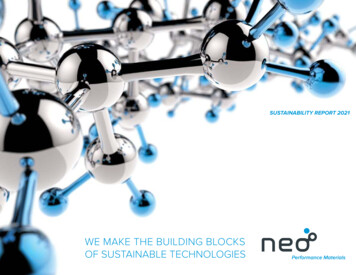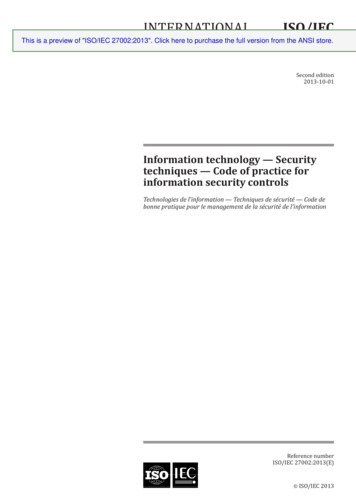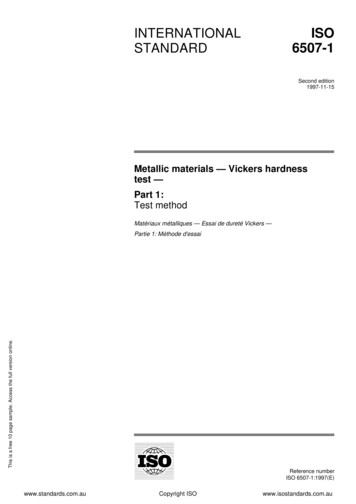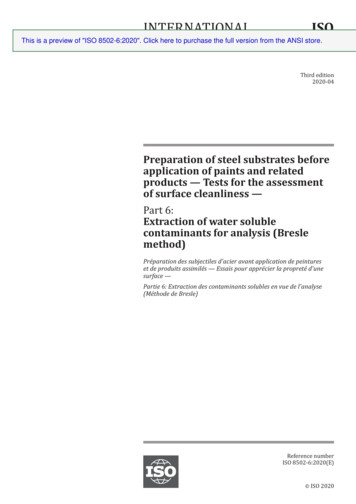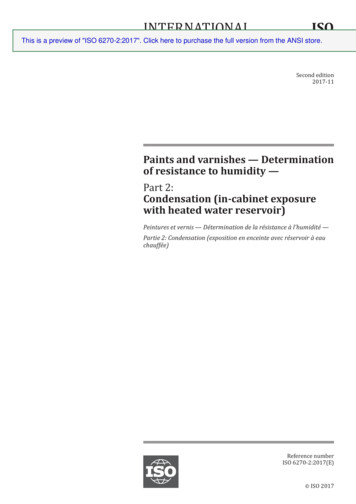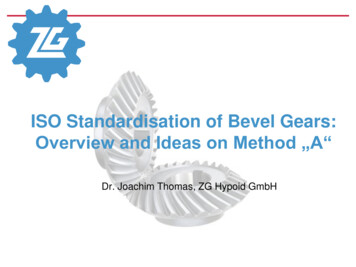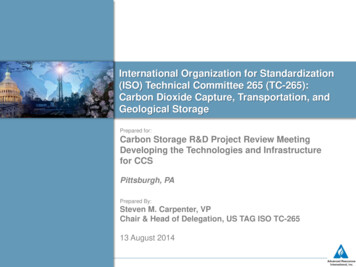
Transcription
International Organization for Standardization(ISO) Technical Committee 265 (TC-265):Carbon Dioxide Capture, Transportation, andGeological StoragePrepared for:Carbon Storage R&D Project Review MeetingDeveloping the Technologies and Infrastructurefor CCSPittsburgh, PAPrepared By:Steven M. Carpenter, VPChair & Head of Delegation, US TAG ISO TC-26513 August 20141
AcknowledgementTraci Rodosta, Director, Sequestration Division & Coordinator,Regional Carbon Sequestration Partnership – DOE-NETLMark Ackiewicz, Division of CCS Research –Program Manager,DOE-FEJerry Hill, Technical Advisor, SSEB2
Regulatory UncertaintySource: Edison Electric Institute and Dick Winschel, CONSOL EnergySource: Edison Electric Institute3
Issues Affecting CCUS Complying with EPA MRR Subpart RR & UU Categorization of CO2 as a solid waste Possible characterization of CO2 as a hazardouswaste Potential conversion of State-based UIC Class IIprograms into UIC Class VI programs EPA’s Prevention of Significant Deterioration (PSD) EPA’s Best Available Control Technologies (BACT)4
One mechanism to addressthese issues International Standards5
What are Standards? Consensus based Designed as a rule, guideline or definition Can be revised & updated Voluntary Standards must fit to purpose:– Prescriptive based– Objectives based– Performance based– Principles based– Hybrids6
Must INCLUDE any and all UNFCCC - IPCC ISO EU European Directives USDOE USEPA NGO’s (WRI, GCCSI, etc.) Federal, Provincial, State regulations Future expected directives7
Why Standards? Because they are not laws – Standards & regulations can work together Not Mandated Typically initiated by industry – And therefore better received and used byindustry because they are part of the process Harmonize across jurisdictions8
Why Standards? Early access to information that couldshape the market in the future Provides a voice for both industry and thepublic in the development of standards Streamline the regulatory process Demonstrate regulatory compliance9
Why Standards?“Standards, smart local andglobal standards, areessential to the timelyadvancement of thetechnologies and equipmentthat will be necessary tomake safe reliable powerwith the capture ofemissions from hydrocarbonfueled power plants.”10Mike Monea, PresidentCarbon Capture & StorageInitiatives Saskatchewan PowerCorporation - Boundary Dam –email to CSA Group
ISO TC 265: Carbon DioxideCapture, Transportation, andGeological Storage11
ISO A Global System Based in Geneva, Switzerland 163 Countries 97% of the World’s population 100,000 international experts 600 organizations in liaison 19,000 International Standards12
ISO Standards Development13
ISO TC 265 – CCS Canada onsNGOs &Liaisons
ISO TC 265: P-MembersParticipating alyJapanKorea15 MalaysiaNetherlands NorwaySouth AfricaSpainSwedenSwitzerlandUnited KingdomUnited States rticipationon all WGs
ISO TC 265: O-MembersObserving Countries:ArgentinaBrazilCzech Rep.EgyptFinland16IranNew ZealandSerbiaSri Lanka Non-votingMembers May requestInternationalExpertParticipationon all WGs May upgradeto P-Memberat any time
ISO TC 265: Liaisons ISO TC207 Environmental Management Non-voting ISO TC67 Petroleum and Natural Gas CEN/TC 234 Gas Infrastructure IEAGHG CO2 GeoNetMembers GuaranteedInternationalExpertParticipationon all WGs Carbon Sequestration Leadership Forum (CSLF) European Industrial Gases Association (EIGA) Global CCS Institute (GCCSI) International Energy Association (IEA) World Resources Institute (WRI)17
TC-265 Working Groups18
WG1: CaptureTechnical Report (TR): Pre-, post-, & oxyfuel combustion capture Industrial processes Separation, purification Dehydration, compression and pumping 4 USMembers All have leadauthor roles Liquefaction, installation, operation, maintenance Quality of CO2 streams Monitoring, management systems Plant retrofitting19
WG2: TransportationPipeline transportation systems boundaries: 2 US Members Pipelines not currentlycovered by existingISO/TC-67 standards Health, safety andenvironment (HSE)aspects specific totransport Monitoring of CO220
WG3: StorageGeological storage of carbon dioxide; Canada(Onshore) Japan (Offshore): Z-741-12 as seed document Site selection Site characterization Risk assessment & risk management Well construction Closure Post-closure21 8 USMembers Many havelead or colead authorroles
WG4: Quantification & VerificationQuantification & Verification Methodology(TR); Led by China, with support fromFrance: Project boundary & leakage CO2 quantification Monitoring and reporting Third party verification Life Cycle Analysis22 4 USMembers
WG5: Crosscutting IssuesDefinitions & Vocabulary; Led by France, withsupport from China: Terminology Definitions System Integration 7 USMembers Many havelead or colead authorroles Public Participation & Engagement Mixing of gas streams from different sources23
WG6: CO2-EORCarbon Dioxide Storage using EOR; led byUSA, with support from Norway: 18 US Members Low-pressure subsurface oilfield operating environments Reservoir & pore spacemanagement Manage known lateralstratigraphic traps in thetarget formation Coordination with WGs1-524 1 - Norway5 - Canada2 - China2 – Japan3 - UK2 - IEA24 Total MembersExpected: France Liaisons
DOE-NETL RCSP Membership25
DOE-NETL Expertise GloballyZ-741-12 – Seed Document Jorg Aarnes, DNV Mike Blincow, Denbury Steve Carpenter, ARI Ian Duncan, UT-BEG Richard Esposito, SoCo Joe Kelly, ADEM Nino Ripepi, VT 3 of 8 Lead Authors 19% of total expertise on the Panel26
DOE-NETL RCSP Expertise GloballyUS TAG to TC-265International WGMembership WG1: Capture WG2: Transportation WG3: Storage WG4: Q&V (MVA) WG5: Crosscutting WG6: CO2-EOR 80% of total expertiseon the US TAG27
Next Steps nexus in the USA 4 Plenary’s to date – Europe & Asia September 2014 – US TAG – Cleveland October 2014 – GHGT-12 – Austin, TXISO TC-265 Panel discussion January 2015 – International WG & Full PlenaryMeeting – Birmingham, AL 26 Countries will engaged with ISO TC-265twice in the USA within 4 months GREAT OPPORTUNITIES TO SHOWCASEDOE-NETL RCSP EXPERIENCE & EXPERTISE28
TC-265 Plenary nexus in the USA Technology Transfer opportunity Best Practices shared and included Quadrennial Review details included Bi-lateral CCUS relationships with China,Korea, & Norway ISO TC-265 may be the single most productiveprocess to increase exposure, use, andinclusion -- especially in Non-OECDeconomies, who are more likely to be the “firstadopters” of ISO TC-265 Standards – of DOENETL experience and expertise29
Thank YouOffice Locations:Washington, DC4501 Fairfax Drive, Suite 910Arlington, VA 22203Phone: (703) 528-8420Fax: (703) 528-0439Houston, Texas11931 Wickchester LaneSuite 200Houston, TX 77043-4574Phone: (281) 558-6569Fax: (281) com30Cincinnati, Ohio1282 Secretariat CourtBatavia, OH 45103Phone: (513) 460-0360scarpenter@adv-res.com
ISO TC-265 may be the single most productive process to increase exposure, use, and inclusion -- especially in Non-OECD economies, who are more likely to be the "first adopters" of ISO TC-265 Standards -of DOE-NETL experience and expertise TC-265 Plenary nexus in the USA

